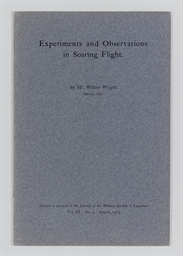WRIGHT, Wilbur (1867-1912). "Experiments and Observations in Soaring Flight." Offprint from: Journal of the Western Society of Engineers Vol. 8 [misprinted "III" on front wrapper], no. 4 (August, 1903). [Chicago, 1903].
WRIGHT, Wilbur (1867-1912). "Experiments and Observations in Soaring Flight." Offprint from: Journal of the Western Society of Engineers Vol. 8 [misprinted "III" on front wrapper], no. 4 (August, 1903). [Chicago, 1903]. A very fine copy of the first edition, offprint issue, of Wilbur Wright's second report of his and Orville's flying experiments, read to the Western Society of Engineers on June 24, 1903. “Of the work described in their second paper Wilbur later testified in 1912: ‘This was the first time in the history of the world that lateral balance had been achieved by adjusting wing tips to respectively different angles of incidence on the right and left sides…We were the first to functionally employ a movable vertical tail in a flying aeroplane. We were the first to employ wings adjustable to respectively different angles of incidence in a flying aeroplane. We were the first to use the two in combination in a flying aeroplane’” (Norman 2267). 8vo (228 x 152 mm). Caption title; 8 photographic halftones in text. Original printed gray wrappers. Brockett 13015; Dibner Heralds of Science 185; Norman 2267. Following the glider trials of 1901, Orville Wright had constructed a wind tunnel in Dayton that the brothers used for a systematic series of tests of over 200 wing and bi-plane combinations. On the basis of these results the brothers built a new glider, equipped with a vertical rear rudder which offset the twisting movements caused by the warping of the wings. The nearly one thousand trial flights made during the summer of 1902 with this superior machine are described in the present report, as are the Wrights' extensive observations of bird flight. The machine functioned well: the Wrights' main objective was to learn how to control it, as, in Wilbur's words, "the machine seemed to have reached a higher state of development than the operators" (p. 8). The second objective of the 1902 experiments was "to obtain data for the study of scientific problems involved in flight" (p. 10). Both goals were realized during the six months following the presentation of this report, and on December 17, 1903--a mere 8 years after their initial entry into aeronautical research--the Wrights made the first motorized flight in history at the Kill Devil Hills, south of Kitty Hawk.
WRIGHT, Wilbur (1867-1912). "Experiments and Observations in Soaring Flight." Offprint from: Journal of the Western Society of Engineers Vol. 8 [misprinted "III" on front wrapper], no. 4 (August, 1903). [Chicago, 1903].
WRIGHT, Wilbur (1867-1912). "Experiments and Observations in Soaring Flight." Offprint from: Journal of the Western Society of Engineers Vol. 8 [misprinted "III" on front wrapper], no. 4 (August, 1903). [Chicago, 1903]. A very fine copy of the first edition, offprint issue, of Wilbur Wright's second report of his and Orville's flying experiments, read to the Western Society of Engineers on June 24, 1903. “Of the work described in their second paper Wilbur later testified in 1912: ‘This was the first time in the history of the world that lateral balance had been achieved by adjusting wing tips to respectively different angles of incidence on the right and left sides…We were the first to functionally employ a movable vertical tail in a flying aeroplane. We were the first to employ wings adjustable to respectively different angles of incidence in a flying aeroplane. We were the first to use the two in combination in a flying aeroplane’” (Norman 2267). 8vo (228 x 152 mm). Caption title; 8 photographic halftones in text. Original printed gray wrappers. Brockett 13015; Dibner Heralds of Science 185; Norman 2267. Following the glider trials of 1901, Orville Wright had constructed a wind tunnel in Dayton that the brothers used for a systematic series of tests of over 200 wing and bi-plane combinations. On the basis of these results the brothers built a new glider, equipped with a vertical rear rudder which offset the twisting movements caused by the warping of the wings. The nearly one thousand trial flights made during the summer of 1902 with this superior machine are described in the present report, as are the Wrights' extensive observations of bird flight. The machine functioned well: the Wrights' main objective was to learn how to control it, as, in Wilbur's words, "the machine seemed to have reached a higher state of development than the operators" (p. 8). The second objective of the 1902 experiments was "to obtain data for the study of scientific problems involved in flight" (p. 10). Both goals were realized during the six months following the presentation of this report, and on December 17, 1903--a mere 8 years after their initial entry into aeronautical research--the Wrights made the first motorized flight in history at the Kill Devil Hills, south of Kitty Hawk.







.jpg)







Testen Sie LotSearch und seine Premium-Features 7 Tage - ohne Kosten!
Lassen Sie sich automatisch über neue Objekte in kommenden Auktionen benachrichtigen.
Suchauftrag anlegen